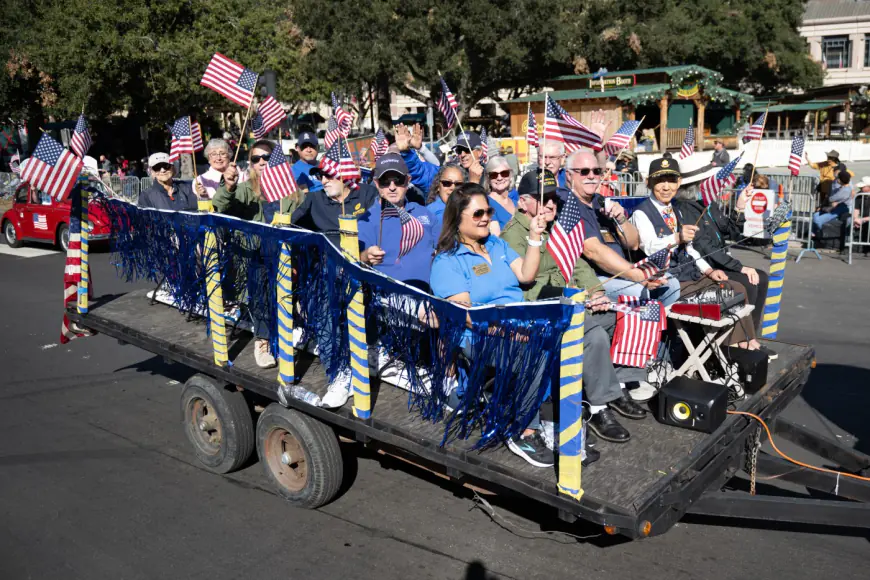Veterans Day: 5 things to know about Bay Area veterans
About 140,000 veterans live in the five-county Bay Area.

On Veterans Day, we honor our country’s 15.8 million military veterans with parades, flag waving and holiday sales.
Ray Watts, a retired colonel in the U.S. Army National Guard, spent the days leading up to Nov. 11 preparing for the long weekend’s celebrations. “When I retired, I was wanting to continue to serve,” said the San Jose resident, now president of the Silicon Valley chapter of the Military Officers Association of America.
He recently jumped into action to help save San Jose’s century-long tradition of a Veterans Day Parade, after organizers announced they were short on funding.
He encouraged people to come out to the parade in San Jose on Monday, to focus on the “critical issues our veterans in Santa Clara County are facing,” such as a lack of employment opportunities and housing, and to show appreciation for veterans and their families.
So who are these veterans, and how many of them live in the Bay Area?
1) The Bay Area has 140,000 veterans
Just over 1.2 million veterans live in California, according to the most recent estimates from the U.S. Census Bureau, and 140,000 of them live in the five-county Bay Area.
Of the Bay Area counties, Contra Costa has the highest concentration of veterans. An estimated 37,591 veterans live in Contra Costa County, or 4.2% of the adult population, which is slightly higher than the statewide average of 4.1%.
According to the 2023 estimates from the Census Bureau’s American Community Survey, the concentration of veterans in California and the Bay Area is lower than the national average of 6.1% of the adult population.
2) Most living Bay Area veterans served in the Vietnam era
Among veterans living in the Bay Area, a quarter served in the post-9/11 era. Another 21% served in the Gulf War before September 2001.
The largest group of veterans, statewide and locally, served during the Vietnam era, including about 50,000 in the Bay Area, nearly 45% of the local veteran population. Another 7% served in the Korean War.
And although their numbers are quickly dwindling, there are still 1,800 WWII veterans in the Bay Area and 8,400 statewide.
Just 1.6% of local veterans served in that war, which ended nearly 80 years ago.
3) Bay Area veterans are mostly older, one in 10 are women
Over half of Bay Area veterans are 65 years and older, slightly higher than the overall adult population, though the region’s adult population trends older than in the state generally.
In California, about 10% of veterans are under 35 years old, and nearly a third are in the oldest age group, 75 years and older.
And while the vast majority of military veterans are men, the more recent generations of veterans have included more and more women. In California, one in 10 veterans is a woman, with 14,000 female veterans living in the Bay Area.
The experience of women veterans is one thing Watts wants to shine more light on. He worries they can be overlooked, especially in discussions of homelessness. “When you see the photographs of the veteran who is unhoused, it’s usually a male,” he said, but he knows many women who served are suffering and at risk, too.
4) About 9,000 Bay Area veterans are living in poverty
While median income for veterans in California is slightly higher than the nonveteran population, $57,700 compared to $41,900, many veterans struggle to find work and housing after their service is over.
That is why Watts’ organization focuses on “those who are unhoused, those who are food insecure, those who are contemplating suicide,” and veterans seeking educational and job opportunities following their service, he said.
According to data from the U.S. Department of Veterans Affairs, in 2023 the number of veterans who experienced homelessness was about 35,600 — an increase of around 7% from January 2022, nationwide.
And according to census estimates, about 91,000 California veterans had incomes below the poverty level in 2023, including 9,000 in Bay Area counties.
5) A shrinking community of veterans
The number of veterans has been steadily declining since the early 1980s, when it peaked at about 28 million, 37% of the adult male population at that time, according to census data.
In 2000, there were 26.4 million military veterans in the country, over 10 million more than there are now.
In California, the number has shrunk from 1.9 million in 2010 to 1.2 million in 2023.
As older generations of veterans die, the newer generations of veterans may not be as involved with existing networks for veterans, Watts said. It worries him.
“Especially here in the Valley, a lot of the nonprofit military-led organizations are struggling to get younger people involved,” he said. “They want to help, but they don’t know how to help.”
What's Your Reaction?









































































































